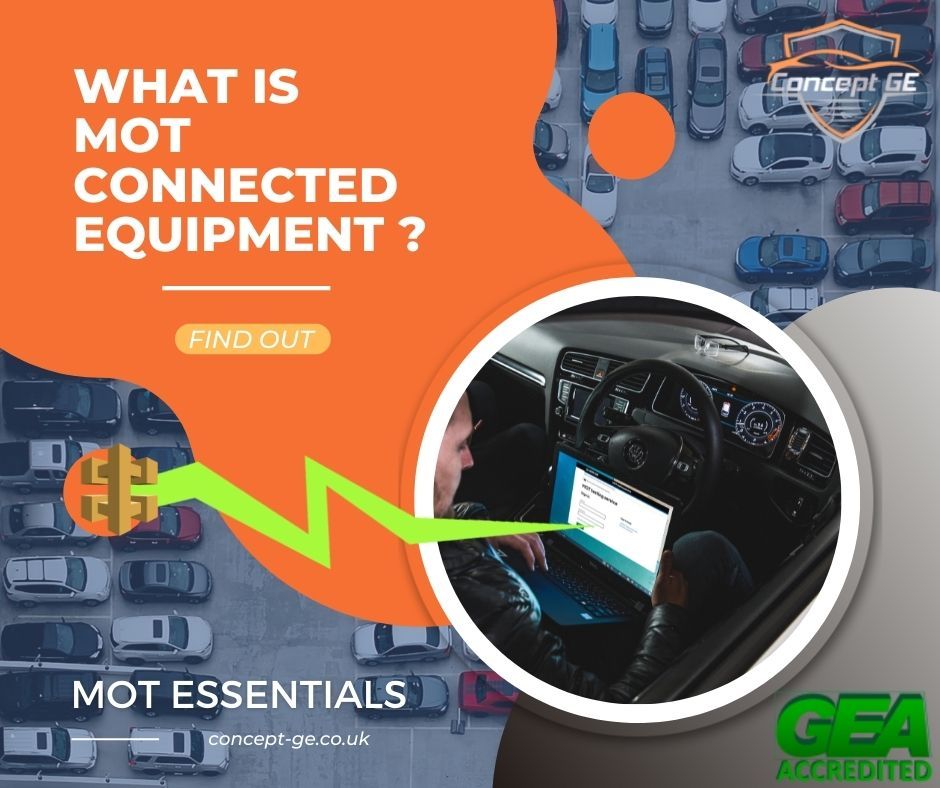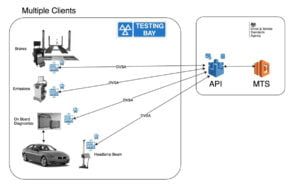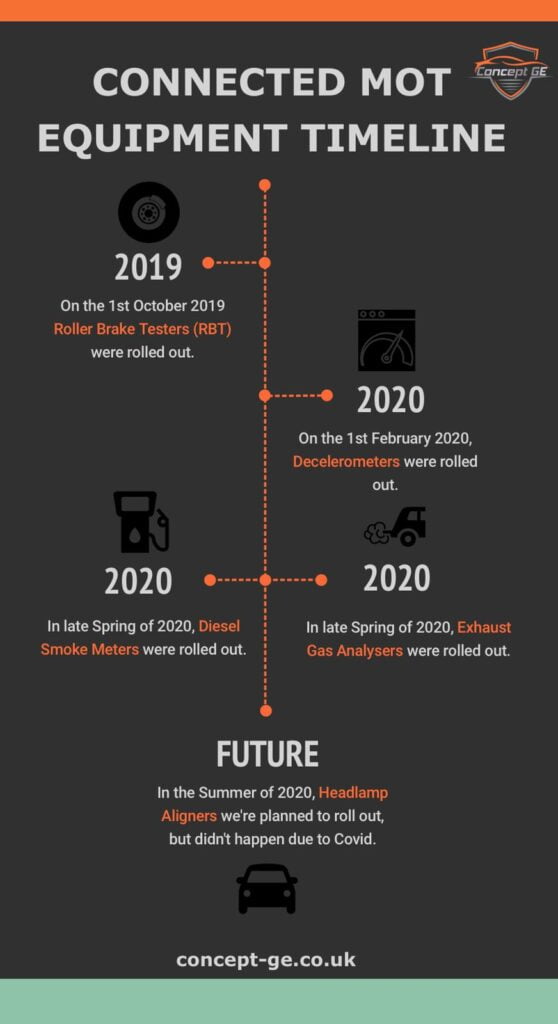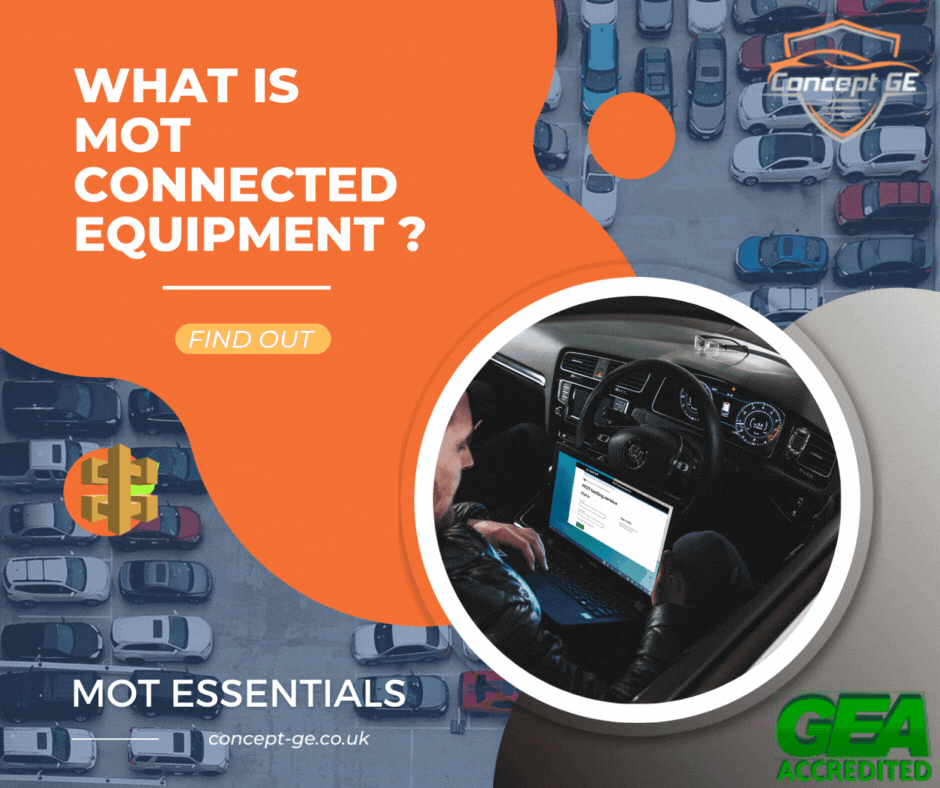Some MOT testing equipment can connect directly to the DVSA via an API to electronically record the MOT test results meaning that less manual intervention is needed. This is known as MOT Connected Equipment and has been an essential requirement for new MOT Bays since 2019.
What is MOT Connected equipment?
From 1st October 2019, The Driver and Vehicle Standards Agency (DVSA), in association with the Garage Equipment Association (GEA) announced they would be enforcing the use of Connected Equipment for MOT testing across the UK, meaning that all new or replacement MOT testing equipment must be able to connect to this new electronic recording service. However, due to the number of garages, manufacturers and pieces of equipment involved, the rollout of this new legislation was to be phased in over several years, from the proof of concept in Q3 2018, the first piece of equipment this applies to in a live environment was roller brake testers (RBTs). The rule applied to all new or replaced RBTs from 1 October 2019.
How are MOT test results recorded and checked?
The MOT testing results have traditionally been entered by hand into the DVSA MOT Testing Service (MTS). Often MOT test results will be either manually recorded or printed from one machine, and then taken and manually entered into the MTS, leading to a slow process, human error, and also open to fraud. This MTS system is used to record the results of the various parts of the MOT test that is carried out, and if the test is passed it is also used to print out the MOT test certificate. The MOT results are also recorded by the DVSA MOT history service. Where a vehicle registration can be used to check the MOT history and results for a vehicle With the introduction of MOT connected equipment, some of this information can be automatically sent to the DVSA MOT Testing Service (MTS) directly from the equipment being used to complete the test, such as Roller Brake Tester (RBT) can send brake test results for the vehicle being tested meaning that the MOT tester does not need to enter these results manually into the MTS.
How does Connected MOT equipment work?
The MOT Connected equipment will record the MOT test results in the usual manner, but during the setup and entry of the vehicle data, the software will communicate with the DVSA MOT Testing System (MTS) system to inform the MTS that an MOT test is being done and that this particular test is being carried out for the vehicle currently being MOT tested. Once the test (for example a roller brake test) is completed, then these results will be sent directly into the MTS system and recorded against this vehicle MOT test To enable the above to happen, the MOT Testing System (MTS) has an Internet of Things (IoT) application programming interface (API) which the garage-based equipment will connect to during the setup and testing process. This API connects via the Amazon Web Services (AWS) cloud to send and receive data between the MOT testing equipment and the MOT Testing System (MTS) itself. The MTS API currently has the capability to accept results from Roller Brake Testers, Decelerometers, Exhaust Gas Analysers and Diesel Smoke Meters and further capability is also planned. There are 2 ways for MOT connected equipment to connect to the MOT Testing System (MTS)
- If you have several pieces of MOT testing equipment from the same manufacturer (for example an MOT Bay Package including a Roller Brake Tester and a Gas & Smoke Analyser), then it’s likely that these will all connect via one central computer in your MOT test centre, and this single computer will connect to the MTS API, as shown below
- However for each piece of MOT testing equipment from a different manufacturer then each separate client would usually connect via its own API interface, instead of using one central PC
What are the reasons for Connected MOT equipment?
Due to the increasing number of cars on the roads of the UK, there are a number of advantages to having MOT connected equipment, these include
- Reducing MOT fraud
- Reducing human error
- Increase Garage Efficiency
- Reduce Costs
- Preparing for vehicles of the future (more ADAS, Electric Vehicles EV, Self-driving / Autonomous Vehicles AV)
When did Connected MOT testing equipment come into force?
As of the 1st of October 2019, the DVSA began a phased introduction of connected MOT testing equipment beginning with roller brake testers (RBTs). From 1 May 2021, any MOT centres that tested class 4,5 and 7 vehicles, must have had this connected equipment installed if they were:
- opening a new MOT centre
- reopening a closed MOT centre
- changing ownership
- replacing emissions testing equipment
Read the full special Connected MOT Equipment notice on this on the gov.uk website – see useful reference links at the bottom of this article.
To who do the MOT Connected equipment rules apply?
The rule around connected MOT equipment applies to any applications to:
- open a new MOT test centre
- reopen a closed MOT centre (regardless of how long it’s been closed)
- change of ownership of an MOT centre (where the MOT centre moves from one authorised examiner (AE) to another, even if this is a family member)
You must also have, or add connected MOT equipment if you plan to:
- replace the current MOT equipment and connected alternatives are available and enforced, such as Roller Brake Testers (RBTs)
- add an extra test lane including new MOT equipment
The rules around connected equipment DO NOT apply if:
- You are making a change to an existing Authorised Examiner (eg. you add a new partner and keep the same AE number)
- your application was received by DVSA before 1 October 2019 – you can install any RBT that was approved at the point you applied
Read the full special Connected MOT Equipment notice on this on the gov.uk website – see useful reference links at the bottom of this article.
What is the MOT Connected equipment timeline?
The original timeline for the connected MOT equipment rollout was as follows
- Roller Brake Testers (RBT) – 1st October 2019
- Decelerometers – 1st February 2020
- Diesel Smoke Meters – Late spring 2020
- Exhaust Gas Analysers – Late spring 2020
- Headlamp Aligners – Summer 2020
Several MOT equipment manufacturers worked tirelessly to achieve these deadlines, however when Covid-19 struck in late 2019 and fully took hold in 2021 through to 2021 many MOT garages closed their doors, furloughed staff, and the MOT tests were granted a 6-month extension to take pressure off garages and also from people not using their cars so much to travel for work. As a result of this, the connected MOT equipment timeline was delayed, and as of this moment, we are awaiting further information on when this will continue. However several MOT equipment manufacturers are taking this as an opportunity to get their equipment ready for connectivity
What are the future plans for MOT Connected equipment?
- Roller Brake Testers – Done
- Decelerometers – Done
- Emissions – Done
- Exhaust Gas Analysers – Done
- Diesel Smoke Meters – Done
Future:
- Headlamp Beam Testers
- On Board Diagnostics
- VIN, MIL, DTC …
Anticipated plans are that a car coming to an MOT testing station for the annual MOT test could be directly connected to the MOT testing equipment, potentially via OBD2 connection. This connection could initiate the MOT test as the VIN and all car data, as well as that of the testing station, could be passed directly to the MOT Testing System (MTS). As each MOT test is completed the results could be passed along with the vehicle data, meaning that little to no manual intervention would be needed. This would make the MOT test a very fast and accurate procedure, with little room for error, or fraud during the process.
Which MOT Testing Equipment has been DVSA approved as Connected MOT Equipment?
All approved MOT Equipment including both connected MOT equipment and that equipment does not yet need to be connected can be found on the GEA website https://gea.co.uk/dvsa-acceptable-equipment/
What are the cost implications of Connected MOT equipment?
In a poll done by Garage Wire in October 2019, half of their readers were against the introduction of MOT connected equipment. Many garages were understandably concerned about the cost of introducing MOT connected equipment as it would mean the replacement of much of their MOT testing equipment. However such cost concerns were alleviated somewhat by the way in which the rules were introduced because it stated that you could continue to use non-connected equipment if no significant changes were being made to your garage setup or ownership. The rules around connected equipment DO NOT apply if:
- You are making a change to an existing Authorised Examiner (eg. you add a new partner and keep the same AE number)
- your application was received by DVSA before 1 October 2019 – you can install any RBT that was approved at the point you applied
However, if a new MOT testing station or a new MOT bay was being opened, ownership of the MOT garage was changed, or even reopen a closed MOT centre 9regardless of how long it had been closed) then the new rules did apply. Some garage equipment manufacturers also went some way to helping the MOT testing business, by introducing relatively inexpensive upgrades to MOT testing equipment where there was already a computer connection in places, such as Roller Brake Testers or Gas & Smoke Analysers, hence adding software upgrades and an internet connection was often all that was needed to allow these pieces of garage equipment to comply with the new rules. However there are no doubt yet to be some discussions around the introduction of connected headlamp beam testers, as these have traditionally been stand-alone machines with no computer or internet connection, so the changes to these will likely be more significant, and potentially more costly for MOT testing stations.
Do I Need to Replace my Existing Equipment with new Connected MOT Machines?
No that is very unlikely, the DVSA never expected or asked every MOT testing station to replace all MOT testing equipment when these new rules were introduced. However, any new MOT testing stations, re-opened MOT garages, or change of ownership would need newly connected MOT equipment to be purchased and installed. Also if any MOT testing equipment breaks down and requires replacement then you must install equipment that complies with the latest regulations. The rule around connected MOT equipment applies to any applications to:
- Open a new MOT test centre
- Reopen a closed MOT centre (regardless of how long it’s been closed)
- Change of ownership of an MOT centre (where the MOT centre moves from one authorised examiner (AE) to another, even if this is a family member)
You must also have, or add connected MOT equipment if you plan to:
- Replace the current MOT equipment and connected alternatives are available and enforced, such as Roller Brake Testers (RBTs)
- Add an extra test lane including new MOT equipment
The rules around connected equipment DO NOT apply if:
- You are making a change to an existing Authorised Examiner (eg. you add a new partner and keep the same AE number)
- Your application was received by DVSA before 1 October 2019 – you can install any RBT that was approved at the point you applied
What happens if Connected MOT equipment fails during an MOT test?
If your MOT testing equipment fails catastrophically during an MOT test then you must stop MOT testing immediately. Contact your equipment manufacturer or supplier to have this repaired or replaced before you begin testing again using this equipment. However, if the issue with the equipment only relates to the connectivity to the MOT testing service (MTS), but the MOT test equipment is otherwise operating correctly, then, you have 7 calendar days to fix the problem. If the connectivity issue is not resolved within 7 days, or the equipment is not operating correctly you must stop MOT testing.
Help with MOT Connected Equipment
If you are considering setting up a new MOT Bay, or upgrading your existing MOT Equipment and are unsure if you will need connected MOT Equipment, please give our sales team at Concept Garage Equipment a call first. We can advise on the best and most appropriate MOT equipment to purchase and will also advise if you don’t need connected equipment depending on your MOT Bay setup and circumstances. We can offer you advice over the phone at 0113 469 0572, we have helped to advise, build, and set up hundreds of MOT Bays across the UK and we have a huge range of MOT equipment and tools. All product prices include delivery as well as free advice on the best use of the MOT equipment, or indeed any other garage equipment up to a full MOT Bay installation. Call us today on 0113 469 0572 or use the website contact form today, we are here to help.
Useful external references:
- Read the full special notice about MOT connected equipment on this on the gov.uk website: https://www.gov.uk/government/publications/mot-special-notice-04-19-mot-connected-equipment/mot-special-notice-04-19-mot-connected-equipment
- Keep updated on MOT Manuals and special notices regarding MOT equipment https://www.gov.uk/topic/mot/manuals
- All approved MOT Equipment including both connected MOT equipment and that equipment does not yet need to be connected can be found here on the GEA website https://gea.co.uk/dvsa-acceptable-equipment
Note: All information is accurate at the time of writing, November 2022.






